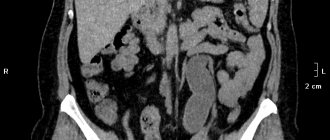The relationship between diarrhea and blood pressure
Despite their widespread prevalence, diarrhea and blood pressure are not directly caused by each other.
These are just individual symptoms, not directly related pathogenetically. They are only concomitant manifestations of the same or different diseases, both organic and functional or psychogenic in nature. Therefore, there is no general advice for treating this condition. In each individual case, the decision should be made by an experienced doctor; only this can give a positive effect and complete recovery.
High pressure target
Whatever the reason for the rise in pressure, the result is the same - the wall of the blood vessels is overloaded, and the formed elements of the blood and large molecules, for example, glucose, like plates with sharp edges, scratch the vascular wall from the inside more and more. And the more microcracks there are, the faster cholesterol will be deposited in them, and the faster an atherosclerotic plaque will begin to form in this place. Well, some organs, which are usually called target organs of hypertension, suffer directly from high blood pressure - the heart is pumped up like a bodybuilder’s biceps, but this only affects its nerves and arteries, the kidneys become overgrown with connective tissue (nephrosclerosis develops), the optic nerve swells and vision deteriorates, the brain suffers. But... even for such serious complications, the count is not in hours or days. This is the result of prolonged, months of high blood pressure.
Diarrhea and hypertension
A combination of symptoms such as high blood pressure and diarrhea often occurs with arterial hypertension. However, it should be understood that there is no direct pathogenetic connection between these conditions. Most often, diarrhea appears as a side effect of taking certain antihypertensive medications. A more rare cause is the addition of some other disease associated with the gastrointestinal tract. In this case, you should contact a cardiologist and adjust your treatment.
However, in the presence of such a pathology as vegetative-vascular dystonia, such a combination is considered a manifestation of this disease. This is due to a violation of the autonomic regulation of internal organs, which is characterized, among many other features, by arterial hypertension, dizziness, nausea and diarrhea. Often these symptoms occur at night. Such signs are especially characteristic during panic attacks or crises of VSD. In this case, the pressure will fluctuate, becoming either high or low. The same combination also occurs in other psychosomatic disorders, including depression.
In the presence of dysfunction of the gastrointestinal tract and diarrhea resulting from it, high blood pressure may be of a psychogenic nature, as a result of constant discomfort caused by diarrhea and a violation of the quality of life. Hypertension often occurs as a result of poisoning and the intoxication syndrome that develops because of it.
Finally, in older people, high blood pressure and profuse diarrhea are often combined with intestinal (rotavirus) flu. The leading symptom of this disease is diarrhea, but hypertension also often occurs. Another significant sign in this case will be fever and chills. The same thing happens with many other infectious diseases.
Treatment of loose stools: how to get rid of the problem
If frequent loose stools bother you for a long time, then most likely its causes lie in a serious imbalance and require immediate treatment. Unlike one-time diarrhea, systematic diarrhea implies complex treatment, which includes not only eliminating symptoms, but also addressing the underlying causes of the syndrome.
Infectious diarrhea
Treatment depends on the form of infectious diarrhea. In mild cases, home therapy is quite possible, including diet, drinking plenty of fluids and taking adsorbent drugs. A severe form of gastroenteric diarrhea requires hospitalization with a whole range of emergency procedures and restorative therapy, which consists of restoring the lost fluid balance and following a diet.
Functional diarrhea
Occurs in disorders of the digestive or nervous system. There are no organic changes in the gastrointestinal tract, and therefore the main treatment in this case is symptomatic. If it is possible to remove the causes of a nervous disorder or irritable bowel, then loose stools may go away within one or two days5.
Diarrhea and low blood pressure: the cause of the condition
A sick stomach or intestines, infectious diseases of the gastrointestinal tract can cause diarrhea, vomiting or hypersalivation (increased salivation). These conditions lead to rapid and massive loss of fluid by the body. The situation naturally leads to a decrease in circulating blood volume, hypovolemia and, consequently, to a decrease in blood pressure. Drinking plenty of fluids can provide significant relief in such cases.
As in the previous case, diarrhea and low blood pressure are often combined with vegetative-vascular dystonia, but only with its hypotonic variant. Loss of strength, anxiety, and loss of appetite will also accompany this syndrome. The reason is still the same - a violation of the nervous regulation of internal organs, which leads to a breakdown in their activity.
Often these manifestations occur during pregnancy, especially in the first trimester. This is due to a sharp hormonal change in the female body, which causes various dysfunctions. Usually this condition goes away on its own after endocrine activity normalizes.
Examination methods
Timely diagnosis is the first step to successful treatment of diseases that are accompanied by nausea, diarrhea, and headache. At the first stage, it is necessary to differentiate infectious diseases and isolate the patient in a hospital if necessary. Next, additional methods are prescribed, thanks to which you can determine the exact cause of poor health. These include:
- bacterial seeding of biological material for accurate determination of pathogens of infectious diseases;
- Ultrasound of the stomach and intestines is the main method for detecting inflammatory processes in these organs;
- endoscopic examination of the mucous membrane of the gastrointestinal tract;
- CT and MRI of the brain are prescribed if various disorders of the central nervous system are suspected.
At the Clinical Brain Institute, the diagnostic scheme is selected individually. It will include only those techniques that are necessary to understand the overall picture of the disease.
What to do if symptoms appear
As you can see, there are many factors that cause diarrhea and blood pressure problems: side effects of drugs, psychological disorders, and some diseases. It is not always possible to figure this out on your own and determine the specific source of the problem.
Therefore, if you find such signs in yourself, immediately consult a doctor to establish an accurate diagnosis and prescribe appropriate therapy. Remember that self-medication can only make you feel worse.
Parasite infestations
Helminths are parasitic organisms that can enter the human body from the outside and then feed at its expense. There are a huge number of types of helminths. They vary in shape and size and can reach up to several meters in length. Parasites most often inhabit the human intestines and feed on digested food. Some varieties are found in the liver and bile ducts, lungs, heart, as well as in blood vessels and other organs.
When the first symptoms appear, it is necessary to undergo tests to determine the type of helminths and begin treatment. These include:
- constant nausea, vomiting;
- diarrhea that alternates with constipation;
- sudden weight loss without changing your diet;
- pain in the stomach and head.
Treatment of helminthiasis takes place in several stages. Initially, the patient is prescribed a gentle diet, and at the same time tests are carried out to determine the type of parasite. The main stage is taking specific anthelmintic drugs, the action of which is aimed at a specific pathogen. After a repeat analysis confirms the complete absence of worms, it is necessary to restore the mucous membrane of the digestive tract and normal microflora. To achieve this, the patient continues to follow a diet and takes enveloping agents.
Other reasons
Nausea, vomiting, diarrhea, headache and fever are nonspecific signs of a number of diseases and conditions. They can be detected with the following violations:
- inflammatory diseases of the stomach and intestines (gastritis, enteritis, colitis), as well as peptic ulcers;
- traumatic brain injuries, blows and bruises to the head;
- stressful situations, nervous tension;
- acute attacks of migraine;
- surges in blood pressure.
When the first symptoms appear in children, you should immediately consult a doctor. Nausea, diarrhea, headaches are signs that may indicate acute and chronic diseases of the digestive tract. With timely treatment, their further development can be prevented and the condition can be maintained with a special diet and medications.
Consequences of a sharp decrease in high blood pressure
And here’s the thing: if you suddenly release the pressure, the same organs can suffer much more severely. Considering that after some time they somehow adapt to even the most significant increase in pressure, a sharp decrease in blood flow and the oxygen it carries can take them by surprise.
The most insidious drugs that can quickly “collapse” blood pressure are nitrates. After a nitroglycerin tablet slipped by compassionate citizens, people often lose consciousness on the street and in transport.
Brain
A sharp decrease in blood pressure can cause a lack of blood supply to the brain. At best, this will manifest itself as a short-term loss of consciousness, which may not end so harmlessly if the fallen person receives a facial injury or concussion. At worst, an ischemic stroke will develop. Especially if the blood supply to the brain is already deteriorated, either as a result of narrowing of the lumen of the carotid arteries by atherosclerotic plaques, or as a result of the development of pathological tortuosity of the carotid arteries, a pathology that often occurs after sixty.
Heart
A sharp decrease in blood pressure can cause not only a stroke, but also a myocardial infarction. The reason for this, in most cases, will be the same atherosclerotic plaques, this time in the vessels of the heart. A sharp decrease in blood pressure will lead to the fact that a section of the myocardium will be without blood supply and the heart cells will die. Moreover, against the background of a decrease in pressure, the heart will reflexively begin to compensate for this situation by accelerating the frequency and strength of heart contractions, which will only increase its need for oxygen, which, due to low pressure, will not be delivered to the myocardium on time.
Kidneys
Another organ that directly depends on blood pressure is the kidneys. And if high pressure is not good for them, then low pressure, frankly speaking, is harmful. Indeed, with low pressure, they cannot carry out their main function - filtering blood and producing urine. Being very sensitive to any changes in pressure, as a result of a sharp drop in the latter, disturbances in the functioning of the kidneys can occur, including the development of renal failure. And one more aspect, if the reduction in pressure was not carried out with drugs that block the renal enzyme ACE (ACE blockers or angiotensin 2 receptor antagonists), then in response to a drop in pressure, a rebound effect is quite possible, when the kidneys quickly release a large amount of the enzyme, and the pressure will jump again.
How to properly reduce high blood pressure?
If it is dangerous to suddenly and significantly reduce blood pressure, how to do it correctly? Doctors recommend not taking a cocktail of drugs, but starting with one drug, preferably a short-acting drug that works for a limited time. If after half an hour the pressure drops by 20 mm Hg. Art., the effect is good and you can take another tablet of the same kind, but no more. If not, try a drug from another group, and then wait an hour. If it doesn’t help, it’s better not to experiment and call an ambulance. Let us recall that according to the standards of treatment of hypertensive crisis, a decrease in systolic pressure by 25% of the initially elevated level is the maximum necessary effect for initial therapy. It is recommended to achieve target values only within 48 hours. It is not necessary to reduce blood pressure by large amounts in the first hours from the onset of the crisis; it is enough to record the success of maintenance therapy and then, after a few hours, begin to gradually increase the dosage of medications.
If you still have questions, you can ask them to a general practitioner or cardiologist online in the Doctis application.










